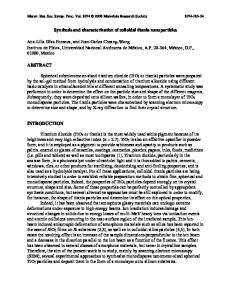Synthesis and characterization of magnetite nanoparticles modified with PEG-based amphiphilic copolymers
- PDF / 678,438 Bytes
- 6 Pages / 612 x 792 pts (letter) Page_size
- 72 Downloads / 372 Views
Synthesis and characterization of magnetite nanoparticles modified with PEG-based amphiphilic copolymers Ryo Kasuya1, Teppei Kikuchi2 and Jeyadevan Balachandran3, Yutaka Tai1 1 National Institute of Advanced Industrial Science and Technology (AIST), 2266-98 Anagahora, Shimoshidami, Moriyama-ku, Nagoya, 463-8560, Japan 2 Graduate School of Environmental Studies, Tohoku University, 6-6-20, Aramaki, Aoba-ku, Sendai, 980-8579, Japan 3 School of Engineering, University of Shiga Prefecture 2500 Yasaka-cho, Hikone, 522-8533 Japan ABSTRACT An aqueous magnetic suspension was prepared by dispersing amphiphilic co-polymer (ACP) coated monodispersed magnetite nanoparticles (MNPs) synthesized through thermal decomposition of iron(III) acetylacetonate in a mixture of oleic acid and oleylamine. ACP composed of poly (maleic anhydride-alt-1-octadecene) and polyethylene glycol methyl ether was applied to disperse MNPs in water and buffer solution. The average diameter of MNPs increased from 6.6 to 12.5 nm with increasing reaction temperature from 200 to 250°C. Infrared spectra and elemental analysis revealed that the surface modified MNPs contain carboxyl groups originated from oleic acid and ACP. The conjugation of MNPs and bovine serum albumin (BSA) antibody was examined. As a result, the as-synthesized MNPs adsorbed BSA antibody effectively than the surface modified MNPs: the BSA antibody adsorption decreased with increasing cross-linker concentration. INTRODUCTION Magnetic fluid hyperthermia is a type of cancer therapy which induces the necrosis of cancer cells by thermal stress caused by raising the temperature above 43°C, utilizing the heat dissipated from magnetic nanoparticles exposed to an alternating current magnetic field. Among various magnetic nanoparticles, magnetite (Fe3O4) has been considered to be suitable thermal seeds due to its biocompatibility and high heating efficiency. Generally, the heat dissipation of magnetite nanoparticles (MNPs) are characterized by the delay in the relaxation of the magnetic moment through either rotation within a particle (Néel relaxation) or rotation of a particle itself (Brown relaxation) [1]. Since particle rotation is inhibited in a medium having high viscosity, the heat dissipation through Brown relaxation is decreased in tumor tissues, where the viscosity is expected to be high. We studied the heating efficiency of MNPs with various diameters in low and high viscosity media and concluded that the diameter of the particle to achieve maximal heat dissipation through Néel relaxation was around 12 nm [2]. In recent years, thermal decomposition techniques have been developed to synthesize MNPs with narrow size distribution. In particular, the method proposed by Maity et al. has been considered viable for the synthesis of MNPs [3]. In this method, the MNPs with average diameters of ≈11 nm or smaller were synthesized by decomposition of iron(III) acetylacetonate (Fe(acac)3) in the presence of surfactants such as oleic acid and oleylamine. We carried out a
detailed investigation of this
Data Loading...











